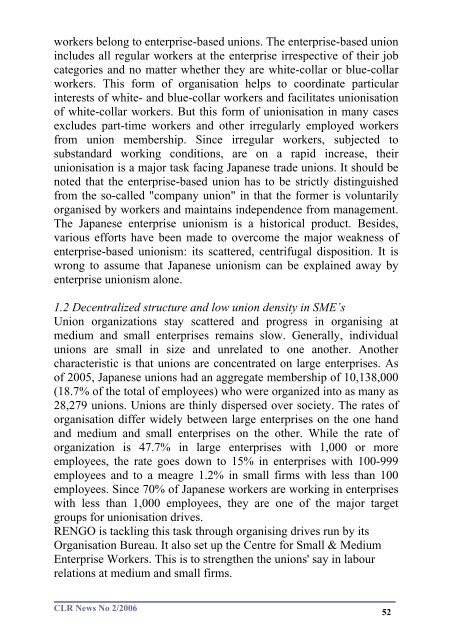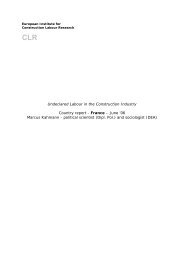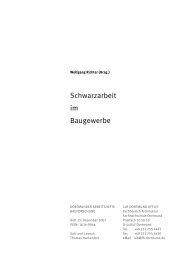Japan – what can we learn? - Construction Labour Research
Japan – what can we learn? - Construction Labour Research
Japan – what can we learn? - Construction Labour Research
You also want an ePaper? Increase the reach of your titles
YUMPU automatically turns print PDFs into web optimized ePapers that Google loves.
workers belong to enterprise-based unions. The enterprise-based unionincludes all regular workers at the enterprise irrespective of their jobcategories and no matter whether they are white-collar or blue-collarworkers. This form of organisation helps to coordinate particularinterests of white- and blue-collar workers and facilitates unionisationof white-collar workers. But this form of unionisation in many casesexcludes part-time workers and other irregularly employed workersfrom union membership. Since irregular workers, subjected tosubstandard working conditions, are on a rapid increase, theirunionisation is a major task facing <strong>Japan</strong>ese trade unions. It should benoted that the enterprise-based union has to be strictly distinguishedfrom the so-called "company union" in that the former is voluntarilyorganised by workers and maintains independence from management.The <strong>Japan</strong>ese enterprise unionism is a historical product. Besides,various efforts have been made to overcome the major <strong>we</strong>akness ofenterprise-based unionism: its scattered, centrifugal disposition. It iswrong to assume that <strong>Japan</strong>ese unionism <strong>can</strong> be explained away byenterprise unionism alone.1.2 Decentralized structure and low union density in SME’sUnion organizations stay scattered and progress in organising atmedium and small enterprises remains slow. Generally, individualunions are small in size and unrelated to one another. Anothercharacteristic is that unions are concentrated on large enterprises. Asof 2005, <strong>Japan</strong>ese unions had an aggregate membership of 10,138,000(18.7% of the total of employees) who <strong>we</strong>re organized into as many as28,279 unions. Unions are thinly dispersed over society. The rates oforganisation differ widely bet<strong>we</strong>en large enterprises on the one handand medium and small enterprises on the other. While the rate oforganization is 47.7% in large enterprises with 1,000 or moreemployees, the rate goes down to 15% in enterprises with 100-999employees and to a meagre 1.2% in small firms with less than 100employees. Since 70% of <strong>Japan</strong>ese workers are working in enterpriseswith less than 1,000 employees, they are one of the major targetgroups for unionisation drives.RENGO is tackling this task through organising drives run by itsOrganisation Bureau. It also set up the Centre for Small & MediumEnterprise Workers. This is to strengthen the unions' say in labourrelations at medium and small firms.CLR News No 2/200652









